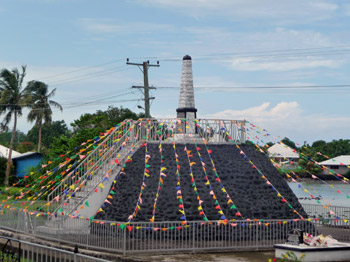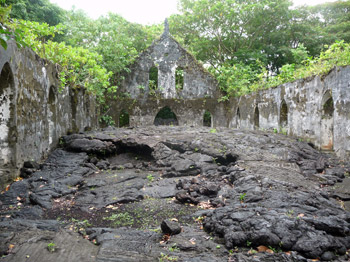
by Clare Gleeson
“And that’s Tana Umaga’s village” said the taxi driver proudly as we drove through the collection of houses and fales. Luckily we were New Zealanders, and my husband is a keen rugby man, otherwise this gem about a former All Black captain may have gone unacknowledged. On our ride from the coast to Apia we had passed several villages which had spawned famous New Zealand sportspeople, although most had not been born in Samoa.
New Zealand and Samoa have had a close relationship since 1914 when New Zealand took control of German Samoa (as opposed to American Samoa) at the outbreak of World War One, controlling what then became Western Samoa until independence in 1962. In 1997 Western Samoa was renamed Samoa. It consists of the two main islands of Upolu and Savai’i plus many smaller ones.
Samoa is relaxed and casual, warm and sunny with friendly people, none of whom are in a hurry. You can go to Samoa to enjoy the beaches and unwind, but there’s also plenty to see and do. I was keen to find what remained of its colonial history.
 Samoa’s capital, Apia, on the island of Upolu, retains a pleasant, rather tired atmosphere that has been lost in the more popular Pacific tourist destinations of Hawaii and Tahiti. Life goes on at a leisurely pace and there are no crowds to negotiate or much traffic on the roads. Apia is small but charming and you can fill in a couple of hours meandering around.
Samoa’s capital, Apia, on the island of Upolu, retains a pleasant, rather tired atmosphere that has been lost in the more popular Pacific tourist destinations of Hawaii and Tahiti. Life goes on at a leisurely pace and there are no crowds to negotiate or much traffic on the roads. Apia is small but charming and you can fill in a couple of hours meandering around.
Down by the harbour is the fish market and browsing the stalls of brightly coloured fish, while enjoying the salty sea air, is a pleasant way to spend an hour.
Across the road from the harbour is the distinctive red colonial building which houses the Chan Mow supermarket. It was originally built in 1912 for Burns Philp (South Seas) Company, a Pacific institution during the late 19th and early 20th centuries.
Between the supermarket and the harbour is the striking clock tower donated to the Samoan people by the family of Taisi Olaf Nelson, the son of a Swedish father and Samoan mother who after New Zealand assumed rule of Samoa was one of the leaders of the independence movement known as the Mau.
 The fruit and vegetable market is in a low slung building in the centre of Apia. The pace on Samoa is slow and languid and neither buyers nor sellers are in a hurry. The efficient Germans brought in Chinese workers rather than rely on Samoans to work in the coconut, cacao and rubber plantations they established.
The fruit and vegetable market is in a low slung building in the centre of Apia. The pace on Samoa is slow and languid and neither buyers nor sellers are in a hurry. The efficient Germans brought in Chinese workers rather than rely on Samoans to work in the coconut, cacao and rubber plantations they established.
Despite our taxi driver’s enthusiasm for sporting heroes the most well-known person associated with Samoa was famous for the use of his pen, not a rugby ball. Christened by the Samoans ‘Tusitala’ or the ‘the teller of tales’ Robert Louis Stevenson arrived in Apia after three years cruising the islands of the Pacific. In 1889 he and his family settled on the island of Upolu where he purchased 400 acres at Vailima and there built a substantial home.
 Vailima was the grandest house on the island with a magnificent staircase and a large room for entertaining which included a fireplace, the only one of its kind in Samoa. Stevenson’s mother, who lived with Stevenson, his wife and step-children in Samoa, brought all her furniture from Scotland, and all other furnishings were imported.
Vailima was the grandest house on the island with a magnificent staircase and a large room for entertaining which included a fireplace, the only one of its kind in Samoa. Stevenson’s mother, who lived with Stevenson, his wife and step-children in Samoa, brought all her furniture from Scotland, and all other furnishings were imported.
Initially Stevenson employed European servants but these were quickly replaced with Samoans who dressed in Stuart tartan skirts on special occasions. Unused to the grandeur of Vailima they had no experience of staircases. One day Stevenson’s wife, Fanny, instructed one of them to take a pail of water upstairs, only to see him grip the handle of the pail in his teeth, then shin up a pole to the veranda.
Today Vailima, still set among extensive grounds, is open to the public. Standing upstairs in the cool of the verandah you can look up to Mt Vaea where Stevenson is buried. His Samoan friends hacked a road out of the bush to form what is now known as the Road of the Loving Hearts which leads to his grave. Two hundred of them carried his body up there. On his tomb is inscribed his famous epitaph:
“Under the wide and starry sky
Dig the grave and let me lie
Glad did I live and gladly die
And I laid me down with a will.
This be the verse you ‘grave for me
Here he lies where he long’d to be
Home is the sailor, home from the sea
And the hunter home from the hill.
 The wide and starry sky Stevenson lies under is far from the gaslights of Edinburgh’s New Town where he was born. You can walk up the Road of Loving Hearts to his grave and gaze out, as he does, across the green of his adopted home to the sparkling blue of the Pacific.
The wide and starry sky Stevenson lies under is far from the gaslights of Edinburgh’s New Town where he was born. You can walk up the Road of Loving Hearts to his grave and gaze out, as he does, across the green of his adopted home to the sparkling blue of the Pacific.
Another great character in Samoa’s history is Aggie Grey, and it’s said ‘Bloody Mary’ in James Michener’s Tales of the South Pacific was modelled on her. Of Samoan and British descent Aggie Grey’s fame began when the US Marines came to Samoa in 1942. She expanded her existing business in Apia into a hotel for servicemen and sold hot dogs and hamburgers, leading to fame throughout the Pacific. Her hotel, ‘Aggie Grey’s’ still operates in Apia today. In the foyer you can have a drink and admire the memorabilia displayed. A drink and a swim in the pool at Aggie Grey’s was a good way to while away a Sunday afternoon when nothing else was open.
 The island of Savai’i, the biggest island in the group and an hour and a half hour ferry ride from Upolu is well worth a visit. At Sapapali’i on Savai’i is a large monument to mark the spot where John Williams of the London Missionary Society landed in 1830 to spread God’s word among the Samoan people. He was obviously successful as religion plays an important part in Samoan life today. There are churches all over the islands and observation of the Sabbath is strict. On Sunday morning whole families go to church dressed in white; the men in lava lavas and the women in dresses and often hats. Apart from hotels there are no restaurants or shops open on Sundays.
The island of Savai’i, the biggest island in the group and an hour and a half hour ferry ride from Upolu is well worth a visit. At Sapapali’i on Savai’i is a large monument to mark the spot where John Williams of the London Missionary Society landed in 1830 to spread God’s word among the Samoan people. He was obviously successful as religion plays an important part in Samoan life today. There are churches all over the islands and observation of the Sabbath is strict. On Sunday morning whole families go to church dressed in white; the men in lava lavas and the women in dresses and often hats. Apart from hotels there are no restaurants or shops open on Sundays.
 Between 1905 and 1911 the volcano of Mt Matavanu on Savai’i erupted and lava poured out destroying five villages. Today the lava fields of Saleaula are an eerie reminder of this disaster. The expanse of black hard molten lava with the odd plant growing has an unreal quality. Driving further on we were shown the ruins of a church buried in the lava by Lily, who lived nearby. Lily showed us the ‘virgin’s grave’ – the grave of a nun untouched by the flowing lava and where flowers have now been planted in the only soil at the site.
Between 1905 and 1911 the volcano of Mt Matavanu on Savai’i erupted and lava poured out destroying five villages. Today the lava fields of Saleaula are an eerie reminder of this disaster. The expanse of black hard molten lava with the odd plant growing has an unreal quality. Driving further on we were shown the ruins of a church buried in the lava by Lily, who lived nearby. Lily showed us the ‘virgin’s grave’ – the grave of a nun untouched by the flowing lava and where flowers have now been planted in the only soil at the site.
Like most Pacific islands Samoa is at the mercy of the weather. Driving around we could see the damage done by the tsunami in 2009 which killed nearly 200 people and rendered 3000 homeless, destroying villages and creating landslides. Samoans are very family oriented and many of the sports personalities mentioned by our taxi driver had returned after the tsunami to help, contributing funds and labour to assist in the rebuilding of villages.


If You Go:
♦ Getting there: Air New Zealand, Virgin Australia and Fiji Airlines fly to Samoa. It is also a popular port for cruise ships.
♦ Accommodation: There is a range of accommodation for all budgets.
♦ Getting around: Some public transport is available but a rental car is the best way to get around.
♦ Eating: Most restaurants are attached to hotels and resorts, but there are a few others. Seafood is a specialty.
All photographs are by Clare Gleeson unless otherwise acknowledged:
Samoan fale
Apia fish market
Apia market
Vailima
Aggie Grey’s hotel (courtesy of aggiegreys.com)
Monument to John Williams
Church in lava fields
About the author:
Clare Gleeson is a New Zealand historian, librarian and travel writer who enjoys exploring her own country as well as those further afield. She has a travel blog at www.thewanderinghistorian.com.




Leave a Reply
You must be logged in to post a comment.